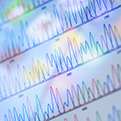
Getty Images / jxfzsy
Two scientific sessions at the 2020 AACC Annual Scientific Meeting & Clinical Lab Expo take a deep dive into next-generation sequencing (NGS), advising on its clinical applications in the important field of oncology.
One of the sessions, Successful Strategies for the Clinical Implementation of Next Generation Sequencing in Oncology in a Hospital Setting (33111), takes place on December 15 from 11 a.m.–12:30 p.m. Central Standard Time and is worth 1.5 ACCENT credit hours.
Successful implementation and validation of NGS assays takes teamwork with people from a variety of technical backgrounds, according to session speakers Robyn Sussman, PhD, and Jennifer Morrissette, PhD, ABMGG, of the University of Pennsylvania (UPenn) in Philadelphia. “Having a development team in the lab that includes wet and dry (bioinformatics and variant review) improves the process and quality of the assay,” they said in a joint statement to CLN Stat.
Sussman, molecular development assistant director for precision and computational diagnostics at the Hospital of the University of Pennsylvania, and Morrissette, associate professor of clinical pathology and laboratory medicine at UPenn, join Mark Ewalt, MD, a pathologist at Memorial Sloan Kettering Cancer Center, who will advise on “managing the monster: NGS sequencing considerations,” and Jeremy Segal, MD, PhD, associate professor of pathology at the University of Chicago, whose presentation focuses on “leveraging the power of the crowd.”
Implementing an NGS assay is daunting—and the hurdles can be significant, the speakers continued. Bioinformatics is one of the biggest challenges labs face when implementing NGS, the UPenn experts continued. To start, not enough bioinformaticists exist. Sequencing companies have addressed this by having onboard informatics on their sequences (Illumina and Thermo Fisher), providing available informatics on the cloud or as a virtual machine (for example, Archer and Agilent), or partnering with outside companies (for example, Swift).
Successful NGS implementation also demands:
- Trained personnel to develop and optimize tests, including research and development (R&D) scientists, data analysts, and bioinformatists.
- Director-level personnel to work along with R&D scientists to ensure that clinical teams’ needs are met and then educate them on how to interpret results.
- Leadership-level personnel getting buy-in from executives on capital expenses and space for accommodating equipment and personnel for testing.
The NGS technology at UPenn today is very different from its early days. For many of the large academic centers, “there was an infusion of knowledge from the research and core laboratories on campus that allowed the clinical implementation to spring forward with implementing the complex workflow necessary for NGS implementation,” said Morrissette and Sussman. Lots of ideal end-to-end solutions now exist for labs. These include isolating DNA to a report readout and kits with onboard bioinformatics. A new market is emerging for end-to-end NGS kits approved by the U.S. Food and Drug Administration.
“Our experience in implementing NGS was driven by the strong clinical and institutional support for having in-house clinical genomics for our cancer patients,” said the UPenn experts. Clinical colleagues in the oncology and pathology space were instrumental in the process. “Getting the clinicians on board so that there was a strong clinical workflow and our continued interactions, using tumor boards to engage with them, and including NGS in ordering algorithms for tumor work-ups can really help.”
Developed under the auspices of AACC’s Molecular Pathology Division, Expanding the Clinical Utility of NGS Assays in Precision Oncology (32102) addresses validation and quality control issues. Laboratories face many challenges in validating NGS assays, said presenter Susan Hsiao, MD, PhD, a molecular genetic pathology specialist at Columbia University Medical Center.
“NGS assays require specialized infrastructure to generate, analyze, interpret, and store NGS data. Obtaining positive control samples and high-quality reference materials that can cover the many types of variants and alterations detectable by NGS can additionally be a challenge,” Hsiao told CLN Stat. Labs can share samples, bioinformatics pipelines, and strategies to overcome these challenges. They should also try to utilize available professional guidelines and other resources, and help develop additional ones, recommended Hsiao.
In her talk, she plans to cover bioinformatic approaches to validating the cancer biomarkers, such as copy number alterations, microsatellite instability, and tumor mutation burden. “I hope this presentation will help participants understand the need for these specialized bioinformatics processes, and that the examples provided will be helpful in selecting a strategy to adopt,” she said.
Hsiao joins two other colleagues at Columbia University Medical Center, Helen Fernandes, PhD, ABB, DABCC, and Mahesh Mansukhani, MD, for this session. Fernandes will discuss the role of quality control materials in validating novel molecular biomarkers. Mansukhani follows up with a talk about validating and utilizing novel molecular microbiology NGS assays.
This session takes place December 14 from 11 a.m.–12:30 p.m. Central Time and is worth 1.5 ACCENT credit hours.